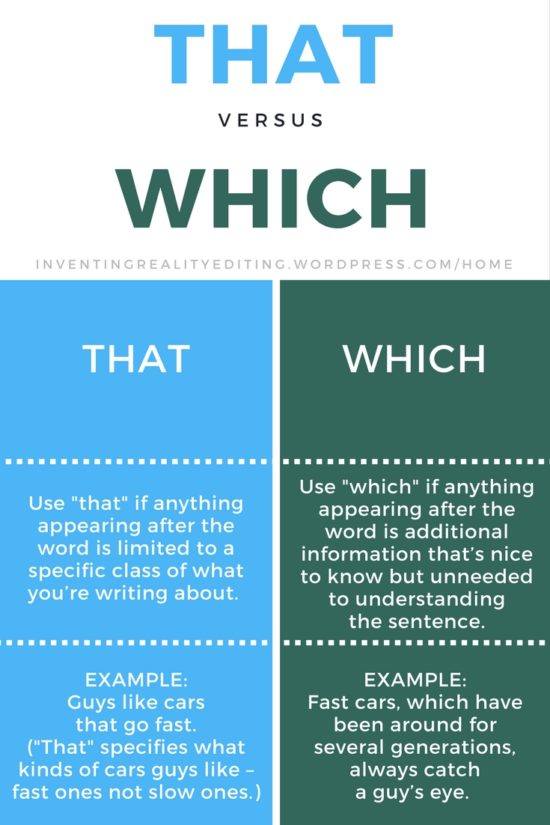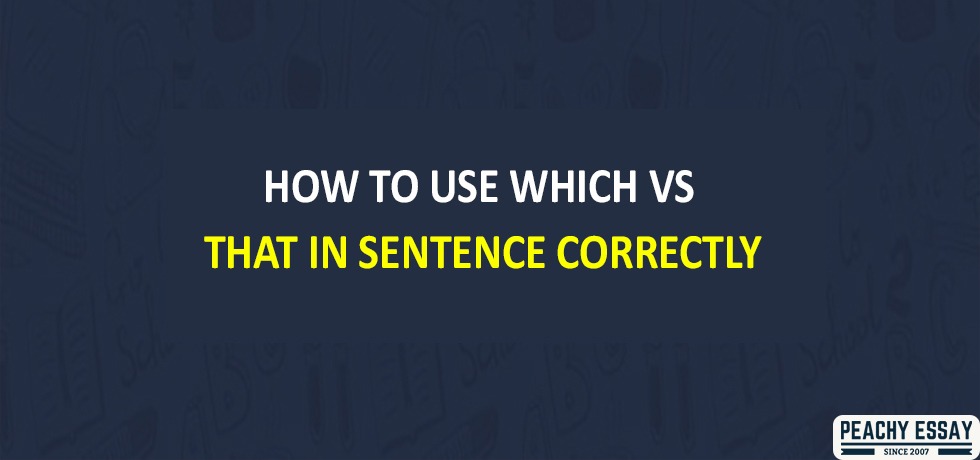WHICH Vs THAT
Are you struggling with when to use that in a sentence vs. when to use which in a sentence? First, you need to understand the meaning of a restrictive clause and a non-restrictive clause. That is used with a restrictive clause, while which is used in a non-restrictive clause. Read on to find out more.
It is very common for people to use the words “which” and “that” interchangeably, and I don’t blame them either, I used to do that too before I knew the difference in their usage. I bet you probably did not know that the words “that” and “which” are function words used to introduce a noun clause. Before you ask, A noun clause is a dependent clause that acts as a noun.
Therefore, the major difference between using that and which in a sentence depends on the type of clause that they are used to introduce.
-
That
is used to introduce a defining clause. This is a clause that defines the full meaning of the sentence. what this simply means is that you should use “that” for parts of the sentence that are really important to the reader or listener to understand the sentence.
-
Which
is used to introduce a non-defining clause. A non-defining clause can be removed from a sentence, and the sentence would still make sense. “which” is more like putting icing on a cake. I mean, you can eat cake without icing but icing just makes it taste so much better.
The rule of thumb here is that which is used in clauses that can be removed from a full sentence without destroying the meaning of a sentence (remember the icing we talked about?). That is used in clauses that define the meaning of a full sentence in which it is used (that is used to make the cake itself, you can’t do without it).
Before you can properly grasp when to use that in a sentence and when to use “which” in a sentence, you need to understand first, the type of clauses that require the usage of these words. Don’t worry, I promise I’ll make it as simple as possible.

Defining clause (THAT)
A defining clause, restrictive or an essential clause is a clause that provides information that is important to the meaning of a sentence. That is used to introduce restrictive clauses. This is the cake I was talking about guys. A defining clause is the cake.
Example: My car that had its windshield broken by some kids has been taken to the workshop for repairs.
It is clear that the speaker in this sentence has more than one car, and he had to specify the car he was referring to. That is used in this sentence to specify the car being talked about has had its windshield broken by some kids. Therefore, if you remove the clause “that had its windshield broken by some kids” from the sentence, you would lose the part of the information that indicates that the owner has more than one car. You basically would be destroying the cake here.
Non-defining/ non-restrictive clause (WHICH)
A Non-defining/non-restrictive clause is used to enhance the meaning of a sentence but is not essential to understanding the meaning of the sentence. A Non-defining clause can be removed from a sentence without restricting the meaning of the sentence. Which is used to introduce the non-restrictive clause in a sentence. A non-restrictive clause usually comes after a comma and ends with a comma too.
This is that icing on the cake, you can choose to keep it or you can decide to remove it. it still works either way.
Example: My car, which had its windscreen broken by some kids, has been taken to the workshop for repair.
In this sentence, the clause “which has its windscreen broken by some kids” is used to enhance the meaning of the sentence. However, if it is removed from the sentence, the sentence would still retain its old meaning. Though you might not remember why the car was taken to the workshop, you would know that the car was taken there, and you know which car.
Therefore, before using that in a sentence, make sure that the clause it introduces is essential to the meaning of the sentence. If not, then you can opt to use which. Which is used for clauses that enhance the meaning of a sentence but do not define those sentences. Cake (that) and Icing (which).
Examples of How That and Which Are Used in Sentences
Example 1:
All the red cars that were shipped to Asia got seized by the government. (cake)
All the red cars, which were shipped to Asia, got seized by the government. (icing)
Example 2:
I drove the black Mercedes, which is owned by my wife, to the supermarket yesterday. (cake)
I drove the black Mercedes that is owned by my wife to the supermarket yesterday. (icing)
Example 3:
Our office, which is made up of two blocks, is located in China. (cake)
Our office that is made up of two blocks is located in China. (icing)
From the examples given above, you can tell that you only use that to show the relevance of a clause to a sentence. While which is only used to enhance the general meaning of a Sentence.
The Informal use of “which”
It is not considered grammatically incorrect to use which in both non-restrictive and restrictive clauses, especially in informal situations.
Example:
Somebody stole the toy that I brought home yesterday.
Somebody stole the toy which I brought home yesterday.
Some wrong usage of “That”
It is wrong to use wrong in sentences that are not the cake. You should, therefore, only use that in cake cases (important details).
Example:
The laptop, that stayed on my table for a year, has stopped working.
The red gun, that my father gave me for Christmas, has been stolen.
My blue car, that had its engine blown, is very fast now.
These are all examples of the wrong ways of using that in a sentence.
Avoid Using “That” successively in the same sentence
This last point is not necessarily a grammatical error. In fact, it may be grammatically correct for you to use the word “that” after a “that.” However, to make your writing more pleasing to the reader, it is better if you trim any use of the word “that” where it is not necessary.
Example1:
He told us that that plan was not ours to use because it was his. Wrong
He told us not to use that plan because that plan was his. Correct
By knowing the role of the clause used in a sentence, you can easily tell when to use which vs. that in a sentence. The ‘cake and Icing’ analogy helps to keep their usage in perspective. If you feel like a part of a sentence is the cake (the important part), then go ahead and use “that.” However, if you can tell that a part of a sentence is the icing (the part of the sentence that can be done without), then you can opt to use “which.”
Question
“hi, this is for use in a professional paper.
Which one of these is correct?
- Tesla is the only electric vehicle maker that can boast of total world domination in terms of sales and popularity, though there are other prominent electric car makers too.
- Tesla is the only electric vehicle maker which can boast of total world domination in terms of sales and popularity, though there are other prominent electric car makers too.”
Answer
Since Tesla is the specific car maker that is being referred to in this sentence, and the clause introduced by “that” is a defining clause, therefore, the correct option is the first one.
(this is the cake part of the sentence).
“Tesla is the only electric vehicle maker that can boast of total world domination in terms of sales and popularity, though there are other prominent electric car makers too.”
Comments:
User 1: Thank you very much for clearing this up for me. 🙂
User 2: This is the most useful resource for explaining grammar usage on the internet.
User 3: I literally clicked on the first link I saw, and I got this blessing.
User 4: what about if I say, “I am ready to buy the Toyota now, the same model that is owned by tom.”
Admin: This is wrong since the second clause is meant to enhance the sentence. The correct one should be, “I am ready to buy a Toyota now, the same model which is owned by Tom.” Or “I am ready to buy the same Toyota model that Tom owns.”
User 5: I really enjoyed the cake and icing analogy.
Peachy Essay provides Language Writing Help Services with a special focus on English Essay Writing. So if you are a student trying to improve your writing, make sure you check our Free Essay Writing Tools available on our website. Our English Literature Writing Help team provides wide range of academic writing services included but not limited to:
– English Literature Assignment Writing Services
– English Literature Essay Writing Services
– English Literature Dissertation Writing Services




